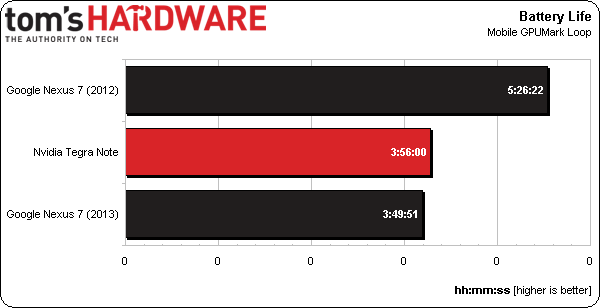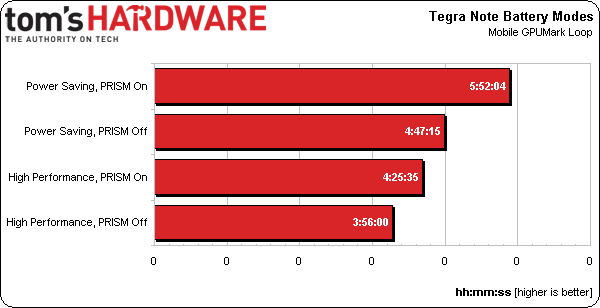EVGA Tegra Note 7 Review: Nvidia's Tegra 4 For $200
Nvidia is partnering with EVGA on the company's second Tegra 4-based device. Its Tegra Note 7 sells for $200, sports unique stylus technology, and ships with a bloatware-free build of Android. Can it set a new standard for affordable seven-inch tablets?
Results: Battery Testing
While we typically use three battery metrics (gaming, video playback, and Web browsing), time did not permit that many full drains and recharges before having to go to publication. So, our battery life metric in this review consists of only one test: gaming. We chose this because the Tegra Note boasts Nvidia's Tegra 4 SoC, and we've only seen that product in a decidedly gaming-oriented device previously, the Shield. Also, our gaming benchmark is the fastest of the three, allowing us to dive deeper into some of the power-saving features that Nvidia includes in its first tablet.
The gaming drain is simply a loop of Mobile GPUMark.
We also had to ditch all our non-7” comparison devices in order to make a meaningful comparison to the Tegra Note.
The results from our most intense battery drain situation have last year’s Tegra 3-powered Nexus 7 topping the charts with nearly five and a half hours of game time, albeit at much lower frame rates than the other two comparison devices. While the Tegra Note places second on our chart, it’s only six minutes more than the Snapdragon S4-based 2013 Nexus 7. Considering that the new Nexus sports a near-QHD screen resolution and the Note is still in 720p-range, it'd appear that Qualcomm steals the battery life win from Nvidia. Bear in mind, though, that in the course of this run from full to empty, Tegra 4 is also generating higher performance than the previous-gen Nexus 7, according to this benchmark chart. If we were to normalize the workload, the Tegra Note wouldn't need to burn through power as fast, and its battery would theoretically last longer.
The next chart shows the Tegra Note in its two most extreme power modes, and with PRISM on and off (explained earlier).
Here we can see that the Tegra Note’s power-saving features scale up exactly how they should. The poorest time is achieved on the High Performance mode with PRISM off. Turning PRISM on nets the device an additional 30 minutes of battery life. Turning PRISM back off and switching to Power Savings mode adds yet another 30 minutes to the Tegra Note’s mobile longevity. Finally, we turn PRISM back on in Power Savings mode to gain yet another hour!
This shows that Nvidia’s energy controls are no gimmick. Going from just under four hours to almost six by flipping a few on-screen switches is quite impressive.
Get Tom's Hardware's best news and in-depth reviews, straight to your inbox.
Current page: Results: Battery Testing
Prev Page Results: Display Measurements Next Page The Tegra Note 7 Is Neat; Is It Worth $200?

